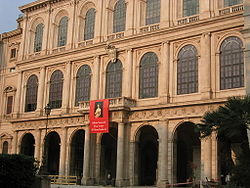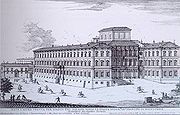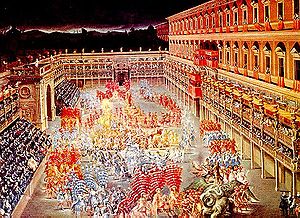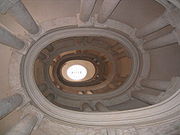
Palazzo Barberini
Encyclopedia

Rome
Rome is the capital of Italy and the country's largest and most populated city and comune, with over 2.7 million residents in . The city is located in the central-western portion of the Italian Peninsula, on the Tiber River within the Lazio region of Italy.Rome's history spans two and a half...
, facing the piazza of the same name
Piazza Barberini
Piazza Barberini is a large piazza in the centro storico or city center of Rome, Italy and situated on the Quirinal Hill. It was created in the 16th century but many of the surrounding buildings have subsequently been rebuilt....
in Rione Trevi
Rione
Rione is the name given to a ward in several Italian cities, the best-known of which is Rome. Unlike a quartiere, a rione is usually an official administrative subdivision...
and is home to the Galleria Nazionale d'Arte Antica
Galleria Nazionale d'Arte Antica
The Galleria Nazionale d'Arte Antica, or National Gallery of Ancient Art, is an art gallery in Rome, Italy, located on two sites: the Palazzo Barberini and the Palazzo Corsini....
.
History
The sloping site had formerly been occupied by a garden-vineyard of the Sforza family, in which a palazzetto had been built in 1549. The sloping site had passed from one cardinal to another during the sixteenth century, with no project fully getting off the ground.When Cardinal
Cardinal (Catholicism)
A cardinal is a senior ecclesiastical official, usually an ordained bishop, and ecclesiastical prince of the Catholic Church. They are collectively known as the College of Cardinals, which as a body elects a new pope. The duties of the cardinals include attending the meetings of the College and...
Alessandro Sforza met financial hardships, the still semi-urban site was purchased in 1625 by Maffeo Barberini, of the Barberini family
Barberini
The Barberini are a family of the Italian nobility that rose to prominence in 17th century Rome. Their influence peaked with the election of Cardinal Maffeo Barberini to the papal throne in 1623, as Pope Urban VIII...
, who then took the papal throne as Pope Urban VIII
Pope Urban VIII
Pope Urban VIII , born Maffeo Barberini, was pope from 1623 to 1644. He was the last pope to expand the papal territory by force of arms, and was a prominent patron of the arts and reformer of Church missions...
.


Carlo Maderno
Carlo Maderno was a Swiss-Italian architect, born in Ticino, who is remembered as one of the fathers of Baroque architecture. His façades of Santa Susanna, St. Peter's Basilica and Sant'Andrea della Valle were of key importance in the evolution of the Italian Baroque...
, then at work extending the nave of St Peter's
St. Peter's Basilica
The Papal Basilica of Saint Peter , officially known in Italian as ' and commonly known as Saint Peter's Basilica, is a Late Renaissance church located within the Vatican City. Saint Peter's Basilica has the largest interior of any Christian church in the world...
, was commissioned to enclose the Villa Sforza within a vast Renaissance block along the lines of Palazzo Farnese; however, the design quickly evolved into a precedent-setting combination of an urban seat of princely power combined with a garden front that had the nature of a suburban villa
Villa
A villa was originally an ancient Roman upper-class country house. Since its origins in the Roman villa, the idea and function of a villa have evolved considerably. After the fall of the Roman Republic, villas became small farming compounds, which were increasingly fortified in Late Antiquity,...
with a semi-enclosed garden.
Maderno began in 1627, assisted by his nephew Francesco Borromini
Francesco Borromini
Francesco Borromini, byname of Francesco Castelli was an architect from Ticino who, with his contemporaries, Gian Lorenzo Bernini and Pietro da Cortona, was a leading figure in the emergence of Roman Baroque architecture.A keen student of the architecture of Michelangelo and the ruins of...
. When Maderno died in 1629, Borromini was passed over and the commission was awarded to Bernini
Gian Lorenzo Bernini
Gian Lorenzo Bernini was an Italian artist who worked principally in Rome. He was the leading sculptor of his age and also a prominent architect...
, a young prodigy then better known as a sculptor. Borromini stayed on regardless and the two architects worked together, albeit briefly, on this project and at the Palazzo Spada
Palazzo Spada
The Palazzo Spada is a palace in the historic centre of Rome, Italy. It is located in the rione Regola, at Piazza Capo di Ferro, 13, very close to the Palazzo Farnese. It has a garden facing towards the River Tiber....
. Works were completed by Bernini in 1633.
After the Wars of Castro
Wars of Castro
The Wars of Castro is a term referring to a series of events in the mid-17th century revolving around the ancient city of Castro , which eventually resulted in the city's destruction on 2 September 1649...
and the death of Urban VIII, the palace was confiscated by Pamphili
Pamphili
The Pamphili are one of the papal families deeply entrenched in Roman Catholic Church, Roman and Italian politics of the 16th and 17th centuries ....
Pope Innocent X
Pope Innocent X
Pope Innocent X , born Giovanni Battista Pamphilj , was Pope from 1644 to 1655. Born in Rome of a family from Gubbio in Umbria who had come to Rome during the pontificate of Pope Innocent IX, he graduated from the Collegio Romano and followed a conventional cursus honorum, following his uncle...
and returned to the Barberini only in 1653.
Architecture
The palazzo is disposed around a forecourt centered on Bernini's grand two-storey hall backed by an oval salone, with an extended wing dominating the piazza, which lies on a lower level. At the rear, a long wing protected the garden from the piazza below, above which it rose from a rusticated basement that was slightly battered like a military bastion. The main block presents three tiers of great arch-headed windows, like glazed arcades, a formula that was more Venetian than Roman. On the uppermost floor, Borromini's windows are set in a false perspective that suggests extra depth, a feature that has been copied into the 20th century. Flanking the hall, two sets of stairs lead to the piano nobile, a large squared staircase by Bernini to the left and a smaller oval staircase by Borromini to the right.
Cour d'Honneur
Cour d'Honneur is the architectural term for defining a three-sided courtyard, created when the main central block, or corps de logis, is flanked by symmetrical advancing secondary wings, containing minor rooms...
.
The Salon ceiling is graced by Pietro da Cortona
Pietro da Cortona
Pietro da Cortona, by the name of Pietro Berrettini, born Pietro Berrettini da Cortona, was the leading Italian Baroque painter of his time and also one of the key architects in the emergence of Roman Baroque architecture. He was also an important decorator...
's masterpiece, the Baroque
Baroque
The Baroque is a period and the style that used exaggerated motion and clear, easily interpreted detail to produce drama, tension, exuberance, and grandeur in sculpture, painting, literature, dance, and music...
fresco of the Allegory of Divine Providence and Barberini Power
Allegory of Divine Providence and Barberini Power (Cortona)
The Allegory of Divine Providence and Barberini Power is a fresco by Italian painter Pietro da Cortona, filling the large ceiling of the grand salon of the Palazzo Barberini in Rome, Italy. Begun in 1633, it was nearly finished in three years; upon Cortona's return from Venice, it was extensively...
. This vast panegyric allegory became highly influential in guiding decoration for palatial and church ceilings; its influence can be seen in other panoramic scenes such as the frescoed ceilings at Sant'Ignazio
Sant'Ignazio
The Church of Saint Ignatius of Loyola at Campus Martius is Roman Catholic titular church dedicated to Ignatius of Loyola, the founder of the Jesuit order, located in Rome, Italy...
(by Pozzo
Andrea Pozzo
Andrea Pozzo was an Italian Jesuit Brother, Baroque painter and architect, decorator, stage designer, and art theoretician. He was best known for his grandiose frescoes using illusionistic technique called quadratura, in which architecture and fancy are intermixed...
); or those at Villa Pisani
Villa Pisani
Villa Pisani is the name shared by a number of villas commissioned by the patrician Pisani family of Venice. However, Villa Pisani usually refers to a large, late baroque villa at Stra on the mainland of the Veneto, northern Italy. It was begun in the early 18th century for Alvise Pisani, the most...
at Stra, the throne room of the Royal Palace of Madrid
Royal Palace of Madrid
The Palacio Real de Madrid is the official residence of the King of Spain in the city of Madrid, but it is only used for state ceremonies. King Juan Carlos and the Royal Family do not reside in the palace, choosing instead the more modest Palacio de la Zarzuela on the outskirts of Madrid...
, and the Ca' Rezzonico
Ca' Rezzonico
Ca' Rezzonico is a palazzo on the Grand Canal in Venice. Today it is a public museum dedicated to 18th century Venice. - Design :Ca' Rezzonico stands on the right bank of the canal, at the point where it is joined by the Rio di San Barnaba. The site was previously occupied by two houses...
in Venice
Venice
Venice is a city in northern Italy which is renowned for the beauty of its setting, its architecture and its artworks. It is the capital of the Veneto region...
(by Tiepolo
Giovanni Battista Tiepolo
Giovanni Battista Tiepolo , also known as Gianbattista or Giambattista Tiepolo, was an Italian painter and printmaker from the Republic of Venice...
). Also in the palace is a masterpiece of Andrea Sacchi
Andrea Sacchi
Andrea Sacchi was an Italian painter of High Baroque Classicism, active in Rome. A generation of artists who shared his style of art include the painters Nicolas Poussin and Giovanni Battista Passeri, the sculptors Alessandro Algardi and François Duquesnoy, and the contemporary biographer Giovanni...
, a contemporary critic of the Cortona style, Divine Wisdom.
The rooms of the piano nobile
Piano nobile
The piano nobile is the principal floor of a large house, usually built in one of the styles of classical renaissance architecture...
have frescoed ceilings by other seventeenth-century artists like Giuseppe Passeri
Giuseppe Passeri
Giuseppe Passeri was an Italian painter of the Baroque period, active in his native city of Rome.Born the nephew of the painter Giovanni Battista Passeri, Giuseppe trained in the studio of Carlo Maratta. Among the paintings by Giuseppe is St...
and Andrea Camassei
Andrea Camassei
Andrea Camassei was an Italian Baroque painter and engraver, who was mainly active in Rome under the patronage of the Barberini.He was born in Bevagna. He was active in painting in the Palazzo Barberini as well as in Antonio Barberini's favored church, Santa Maria della Concezione, where he...
, plus, in the museum collection, precious detached frescoes by Polidoro da Caravaggio
Polidoro Caldara da Caravaggio
Polidoro Caldara, usually known as Polidoro da Caravaggio was an Italian painter of the Mannerist period, "arguably the most gifted and certainly the least conventional of Raphael's pupils", who was best known for his now-vanished paintings on the facades of Roman houses...
and his lover Maturino da Firenze
Maturino da Firenze
Maturino da Firenze was an Italian painter, born in Florence, but working in Rome during the Renaissance.Vasari described the relationship between Polidoro da Caravaggio and Maturino as exceedingly close:...
.
The garden is known as a giardino segreto ("secret garden"), for its concealment from an outsider's view. It houses a monument to Bertel Thorwaldsen, who had a studio in the nearby Teatro delle Quattro Fontane
Teatro delle Quattro Fontane
The Teatro delle Quattro Fontane is an opera house in Rome, Italy, designed by Gian Lorenzo Bernini and built in 1632 by the Barberini family...
in 1822-1834.
Modern history and attractions
Today Palazzo Barberini houses the Galleria Nazionale d'Arte AnticaGalleria Nazionale d'Arte Antica
The Galleria Nazionale d'Arte Antica, or National Gallery of Ancient Art, is an art gallery in Rome, Italy, located on two sites: the Palazzo Barberini and the Palazzo Corsini....
, one of the most important painting collections in Italy. It includes, among many others, Raphael's
Raphael
Raffaello Sanzio da Urbino , better known simply as Raphael, was an Italian painter and architect of the High Renaissance. His work is admired for its clarity of form and ease of composition and for its visual achievement of the Neoplatonic ideal of human grandeur...
portrait La fornarina
La Fornarina
The Portrait of a Young Woman is a painting by the Italian High Renaissance master Raphael, made between 1518 and 1520. It is in the Galleria Nazionale d'Arte Antica in Palazzo Barberini, Rome....
, Caravaggio's
Caravaggio
Michelangelo Merisi da Caravaggio was an Italian artist active in Rome, Naples, Malta, and Sicily between 1593 and 1610. His paintings, which combine a realistic observation of the human state, both physical and emotional, with a dramatic use of lighting, had a formative influence on the Baroque...
Judith Beheading Holofernes
Judith Beheading Holofernes (Caravaggio)
Judith Beheading Holofernes is a work by Michelangelo Merisi da Caravaggio, painted in 1598-99. The widow Judith first charms the Assyrian general Holofernes, then decapitates him in his tent.- Subject :...
, and a Hans Holbein
Hans Holbein the Younger
Hans Holbein the Younger was a German artist and printmaker who worked in a Northern Renaissance style. He is best known as one of the greatest portraitists of the 16th century. He also produced religious art, satire and Reformation propaganda, and made a significant contribution to the history...
portrait of Henry VIII
Henry VIII of England
Henry VIII was King of England from 21 April 1509 until his death. He was Lord, and later King, of Ireland, as well as continuing the nominal claim by the English monarchs to the Kingdom of France...
.
The palace is also home to the Italian Institute of Numismatics.
The European Convention on Human Rights
European Convention on Human Rights
The Convention for the Protection of Human Rights and Fundamental Freedoms is an international treaty to protect human rights and fundamental freedoms in Europe. Drafted in 1950 by the then newly formed Council of Europe, the convention entered into force on 3 September 1953...
(ECHR) was signed here on 4 November 1950, creating the European Court of Human Rights
European Court of Human Rights
The European Court of Human Rights in Strasbourg is a supra-national court established by the European Convention on Human Rights and hears complaints that a contracting state has violated the human rights enshrined in the Convention and its protocols. Complaints can be brought by individuals or...
, and is a milestone in the protection of human rights.
Hidden in the cellars of the rear part of the building a Mithraeum
Mithraeum
A Mithraeum is a place of worship for the followers of the mystery religion of Mithraism.The Mithraeum was either an adapted natural cave or cavern or an artificial building imitating a cavern. Mithraea were dark and windowless, even if they were not actually in a subterranean space or in a natural...
was recently found, dating probably from the second century AD.
External links
- Il palazzo Barberini: official site (in Italian)
- Rome Art-Lover: Palazzo Barberini
- Palazzo Barberini and Veneto Rome guide
- Italian army ends museum stand-off, BBC News, Friday, 13 October 2006
- Google Maps. The complex constituting the Palazzo Barberini is in the center, set back from the road on all sides, and askew. On the lower side of the image are the start of the Quirinal PalaceQuirinal PalaceThe Quirinal Palace is a historical building in Rome, Italy, the current official residence of the President of the Italian Republic. It is located on the Quirinal Hill, the tallest of the seven hills of Rome...
gardens. Below, and in the first corner on the right, is the San Carlo alle Quattro FontaneSan Carlo alle Quattro FontaneThe Church of Saint Charles at the Four Fountains is a Roman Catholic church in Rome, Italy. Designed by the architect Francesco Borromini, it was his first independent commission. It is an iconic masterpiece of Baroque architecture, built as part of a complex of monastic buildings on the Quirinal...
. Diagonally opposite and above is the triangular Piazza BarberiniBarberiniThe Barberini are a family of the Italian nobility that rose to prominence in 17th century Rome. Their influence peaked with the election of Cardinal Maffeo Barberini to the papal throne in 1623, as Pope Urban VIII...
with the Triton FountainTriton FountainThe Triton Fountain is a seventeenth century fountain in Rome, by the well-known Baroque sculptor Gian Lorenzo Bernini...
.

